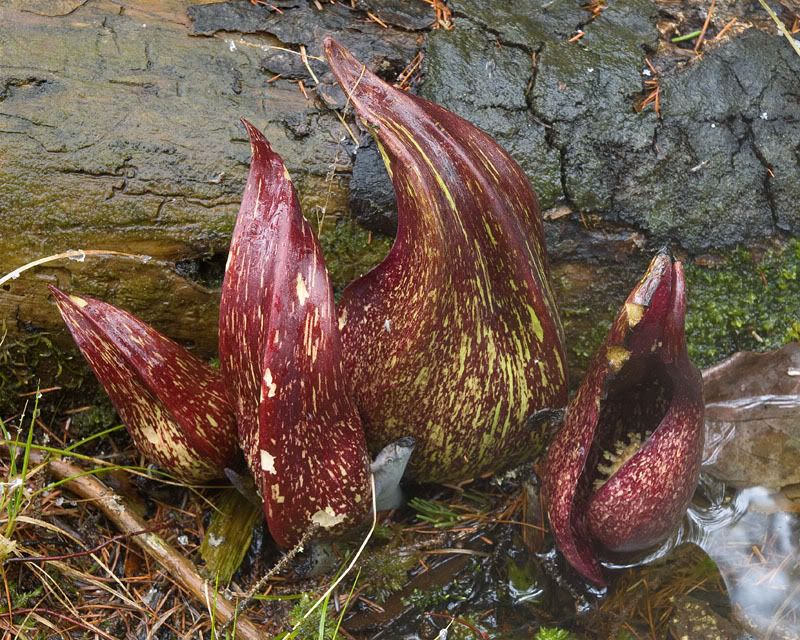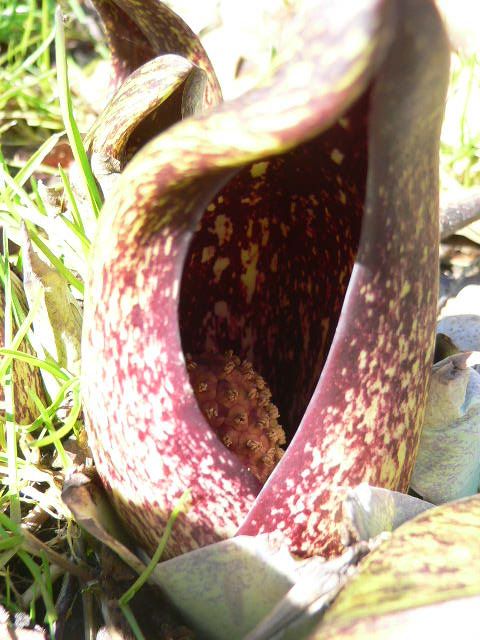The flower, which appears in late winter before the leaves, features a stalked, elliptoid, pale pink spadix (the reproductive part) about 1 inch long, studded with small yellow flowers, and partially shielded by a mottled, purple and green, long-oval spathe, 3 to 6 inches tall. It generates enough heat to melt the surrounding snow, while the odor attracts the yearís first flies to this heated haven. They mate there and pollinate the flowers.
The smooth-edged, long-oval to heart-shaped leaves come up in March (sometimes also in late fall, when they complete their development). First wrapped like scrolls, they grow 1-1?2 to 3 feet tall and 1 to 2 feet long.
In mid-summer and fall, an inconspicuous, low, flattened, green, egg-shaped fruit, 2 to 3 inches across, its surface convoluted like a brain, appears in the mud, turning black as it matures. Inside, a circle of 10 to 14 roughly globular seeds lines the periphery.
Caution: Deadly false helleboreÝ(Veratrum viride) superficially resembles skunk cabbage, and the plants often grow side by side. Odorless, false hellebore leaves look pleated, with prominent parallel veins, while skunk cabbageís inconspicuous veins branch.
The leaves, which appear in early spring (they sometimes also appear in late fall, but don't complete their development) are first wrapped like a scroll.

HABITAT: Skunk cabbage grows in large, dense stands in wet woods and swamps. And it grows in a certain area in eastern Asia too. Even though the 2 populations have been separated for 6 to 8 million years, the plantsí forms are identical, and they interbreed readily. For a long time, biologists couldnít figure out why they didnít evolve into 2 different species incapable of interbreeding in all that time.
It turns out that once a new species comes into existence, it remains unchanged for millions of years, through ice ages and hot climates, until it finally goes extinct. New species may branch off and evolve from an isolated pocket population of the parent species in as few as tens of thousands of years, only to continue unchanged for millions of years as well. And the stagnation of skunk cabbage in Asia and America (it does grow in swamps after all) supports this take on the scale of evolution's operation, and explains the conundrum.

MEDICINAL USES: An ointment made by boiling skunk cabbageÝroots in oil is said to be good for ringworm (a fungal infection of the skin), as well as sores and swellings.
I'd be willing to try this plant externally, but I'll let someone else swallow the tea made from the roots or seeds first. Such an infusion is supposedly antispasmodic, diaphoretic (inducing sweating and stimulating the immune system), and expectorant (bringing up phlegm), and it reputedly acts as a narcotic for asthma. It ís supposed to be good for arthritis, chorea, hysteria, edema, whooping cough, worms, epilepsy, and convulsions in pregnancy and labor (the Iroquois would pass the seeds over female genitals to bring on childbirth). I doubt that all these claims could be verified scientifically.

I've never tried crushing this but now I'm going to, lol! I'm with you on the external use and not the internal...at least until I know someone personally that uses it!
ReplyDeleteThanks for the good share Sister Love...
So good to see you back here sharing your knowledge!
Blessings and Happy Weekend!
Love You Immensely...Always!
Love you sooo!
ReplyDelete